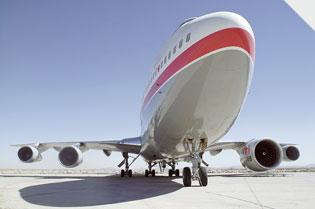
SKY RAMP TECHNOLOGY
While advances in rocket technology have slowed
over the past 40 years, jet engine technology continues to soar. Lighter
materials, larger engines, and better blades provide much more powerful
engines. The General Electric GE90-115B is the world's largest
jet engine and FAA certified for 115,000 lbs of thrust, although it demonstrated
127,900 lbs. It is now in use on two-engine Boeing 777 aircraft; it was tested by GE
on a 747 aircraft (it's the larger engine at right). Note
that jet engines used by the first 747s provided just 40,000 lbs of thrust
each. A sled would require a dozen of these powerful jet engines to launch an
single-stage RLV into orbit, making the concept questionable. However, a
sled with four or six engines would prove valuable for ground testing, providing
the velocity to ignite ramjets on aircraft or spacecraft, launching craft with
stub wings, or to assist launch
expendables. While rockets generate much more thrust, jets have many advantages:
It is now in use on two-engine Boeing 777 aircraft; it was tested by GE
on a 747 aircraft (it's the larger engine at right). Note
that jet engines used by the first 747s provided just 40,000 lbs of thrust
each. A sled would require a dozen of these powerful jet engines to launch an
single-stage RLV into orbit, making the concept questionable. However, a
sled with four or six engines would prove valuable for ground testing, providing
the velocity to ignite ramjets on aircraft or spacecraft, launching craft with
stub wings, or to assist launch
expendables. While rockets generate much more thrust, jets have many advantages:
1) Jet engines are much safer to fuel and operate. After billions of flight hours, there are few cases where a jet engine blew up.
2) Jet engines are reusable 100,000 times rather than 100 times for rockets.
3) The sled can be smaller since jets suck oxygen out of the air while rockets must carry their own liquid oxygen, which must be kept extremely cold.
4) Jet engines can be quickly and safely refueled, even while the engine is still running.
5) Jet engines are much cheaper to maintain and operate. Each new GE90-115B costs $15 million each and support costs are shared by dozens of commercial airlines so parts and trained personnel are easily available.
A sled with jet engines can use aircraft wings so the engines are mounted in the exact manner as commercial aircraft. Current Boeing flight control systems can be used to control the engines and wing flaps. Boeing wings are already designed with internal fuel tanks, so engines can draw fuel directly from the wings. The wing flaps can help turn a sled upward as it accelerates up a curved track, and later used to help brake the sled.
Four GE90-115Bs can provide 510,000 lbs of thrust, and six can put out 767,000 lbs. Since commercial engines are not designed for supersonic speeds, a jet sled powered by commercial engines may be limited to Mach. The most powerful supersonic engines used by the new F-22 can reach Mach 2.5+, but only put out 35,000 lbs of thrust with afterburner. A jet powered sled has a better chance of attracting funding since the track can be used by engine and aircraft makers for tests. GE may even provide the engines for free if it can use the track for testing and publicity. It will also provide a much less expensive method of conducting high speed sled tests than today's rockets. There is no doubt this will work, success is guaranteed.
Launch Sequence for Jet Assist
A typical jet sled launch would start horizontally with the jet engines building up speed to ~200 mph before beginning the upward curve, aided by the sleds wings. As the curve ends and the sled is at a launch angle of ~45 degrees and ~300 mph, the engine(s) on the craft carried on the sled fire and reach full thrust after three seconds. (Rockets on vertical launched vehicles are fired three seconds prior to launch to ensure full thrust at release.) With a sled system, the fuel burned during the engine start also provides thrust for launch. This is also a simpler and safer method than holding down a spacecraft with explosive bolts while rocket thrust torches the launch pad.
After reaching full thrust, the rocket engine is throttled back for sled separation at ~400 mph. The actual release velocity may be higher, depending on the mass of the launched craft, the length of the track, and the number of jet engines. At this point, the jet engines cut to zero thrust and the craft released. Rocket engines increase to full thrust once it has cleared to avoid torching the sled. A rocket can use its moveable nozzle to turn upward and toward the desired launch azimuth, while a winged vehicle may use flaps. This allows a two-stage to orbit rocket to make orbit with large payloads. It may allow a single rocket core from the new Atlas V or Delta IV rockets to match the performance of the three-pack cores of the "heavy" versions.
Using a jet powered sled to heave spacecraft or aircraft upward at several hundred miles an hour provides tremendous benefits in fuel saving. It is also much safer, as explained in the Safety section. Finally, launching off a rail at ~10,000 feet skips 25% of the atmosphere and allows for a smaller, lighter rocket nozzle which allows the rocket engines to burn ~4% more efficiently, as explained in the High Altitude Launch section. Doubling the payload of current expendables with a 400 mph launch assist off a jet sled will be a major advance and allow the USA to reclaim the commercial launch market.